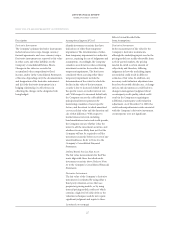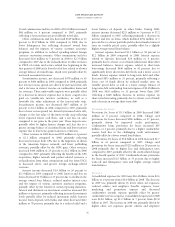American Express 2009 Annual Report Download - page 30
Download and view the complete annual report
Please find page 30 of the 2009 American Express annual report below. You can navigate through the pages in the report by either clicking on the pages listed below, or by using the keyword search tool below to find specific information within the annual report.
2009 FINANCIAL REVIEW
AMERICAN EXPRESS COMPANY
FAIR VALUE MEASUREMENT (CONTINUED)
Description Assumptions/Approach Used
Effect if Actual Results Differ
from Assumptions
models are readily observable from actively
quoted markets. In each case, the valuation
models used are consistently applied and
reflect the contractual terms of the
derivatives, including the period of
maturity, and market-based parameters
such as interest rates, foreign exchange rates,
equity indices or prices, and volatility.
Credit valuation adjustments are
necessary when the market parameters (for
example, a benchmark curve) used to value
the derivative instruments are not indicative
of the credit quality of the Company or its
counterparties. The Company considers the
counterparty credit risk by applying an
observable forecasted default rate to the
current exposure.
The Company manages derivative
instrument counterparty credit risk by
considering the current exposure, which is
the replacement cost of contracts on the
measurement date, as well as estimating the
maximum potential value of the contracts
over the next 12 months, considering such
factors as the volatility of the underlying or
reference index. To mitigate derivative
instrument credit risk, counterparties are
required to be pre-approved and rated as
investment grade. The Company’s derivative
instruments are classified in Level 2 of the
fair value hierarchy. Refer to Notes 3 and 12
to the Company’s Consolidated Financial
Statements.
28
























